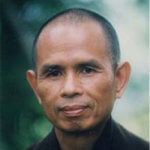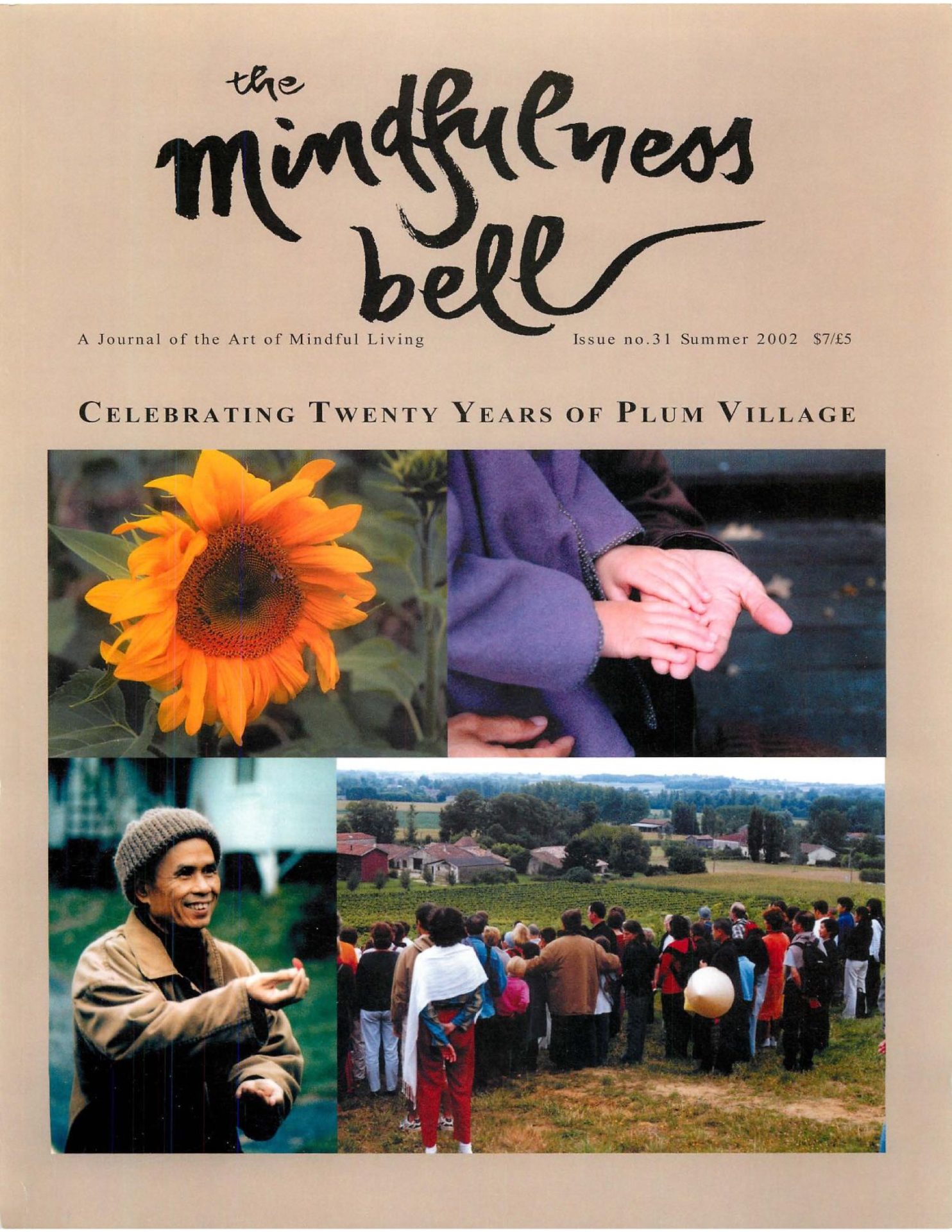By Thich Nhat Hanh in June 2002
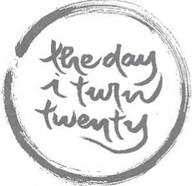
Dear Sangha, today is the 13th of December 2001. We are in the Dharma Nectar Hall, at the Lower Hamlet, during the winter retreat. The committee, working on the book for the twentieth anniversary of Plum Village has asked me to talk about the history of Plum Village so that they can include it in the book. There are so many stories to recount that I don’t know where to start!
By Thich Nhat Hanh in June 2002

Dear Sangha, today is the 13th of December 2001. We are in the Dharma Nectar Hall, at the Lower Hamlet, during the winter retreat. The committee, working on the book for the twentieth anniversary of Plum Village has asked me to talk about the history of Plum Village so that they can include it in the book. There are so many stories to recount that I don’t know where to start!
The Six Umbrella Pines
We found the Lower Hamlet on the 28th of September 1982. Before this, we had found the Upper Hamlet. When we went to take a look at the Upper Hamlet, I liked it immediately, because it was beautiful. I saw the path that could be for our walking meditation, and I fell in love with it at first sight. However, Mr. Dezon, the land owner of the Upper Hamlet, did not want to sell it. He loved that piece of land very much; he could not let it go. We understood this, since he had been a farmer there for a long time. After a few days, we found the Lower Hamlet. Having purchased the Lower Hamlet, we still wanted the Upper Hamlet. Therefore, we continued to pay attention to what was going on up there. That year, there was a hailstorm that destroyed all the owner's vineyards. He got angry and put it on the market for a very high price, not to have more money, but so that he would not have to sell it. In spite of the increased price, we bought it, because we liked the land so much. As a result, we had the Lower Hamlet first, then after a few months, we had the Upper Hamlet as a part of Plum Village. In previous years we held the summer retreat in the Sweet Potato Hermitage in the North of France. It was, however, such a small center that we could not receive many meditation students. As a result, we came to the South to look for land and establish a practice center that could receive more people.
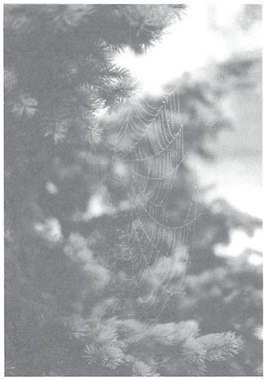
We decided to open Plum Village to the public right away during our first summer, in 1983. Thus, from the winter of 1982 to the summer of 1983, we had to work a lot. At the beginning of 1983, we began to plant some trees in the Upper Hamlet. The first trees we planted were six umbrella pine trees with the help of a local farmer. The land in the Upper Hamlet was full of rocks, so we needed his machine to dig holes for the trees . We put a little bit of cow manure in the bottom of each hole before planting the trees. It was raining on that day and everybody was soaked. Afterwards, I got sick and stayed in bed for three weeks. Everybody was worried. Fortunately, after a while I could get up and eat some rice soup.
In those days, we did not call it Plum Village, we called it Persimmon Village which was the name of a practice center the School of Youth for Social Service and the Order of Interbeing had planned on building in Vietnam, so that their members could come to practice and nourish themselves. In the 1950s, we had the Fragrant Palm Leaves center in the highlands of Vietnam, in Blao. You would know about that center if you have read the book Fragrant Palm Leaves. However, the School of Youth for Social Service wanted to have a center closer to the city. When I wrote The Miracle of Mindfulness, I also mentioned the idea of founding a practice center called Persimmon Village. Eight years later, we managed to find the Lower Hamlet and our vision came true. We had thought of planting persimmons but we realized that it was not practical, so we planted plum trees instead. We were still naive, thinking that if we planted many plum trees, we could have enough income to support ourselves. We were not horticulturists, so we did not do very well. We have enjoyed more plum blossoms than plums.
The name Plum Village is beautiful, so we changed it from Persimmon Village to Plum Village. In reality, we had only planted a few dozen persimmon trees, but we had planted 1,250 plum trees. Many of those first plum trees that we planted were bought with the pocket money given to us by children who came to Plum Village. The children were told that in seven years the plum trees would give fruits; those fruits would be dehydrated and sold, and that money would be used to help hungry children in Vietnam or in other poor countries. Many children saved their pocket money in order to plant plum trees. Sometimes the children would combine their pocket money to plant a plum tree. It cost thirty-five French francs to plant a baby plum tree. We planted 1,250 trees because that was the number of the original monastic Sangha of the Buddha.
In May of 1983 we held our first Summer Opening with 117 practitioners. We did not yet have the practice of touching the earth or the daily practice with gathas, meditation poems. However, we already had sitting meditation, walking mediation, tea meditation, and consultations. There were not yet monks and nuns, so I had to lead all the practices from the beginning to the end, from A to Z. I had to walk around and correct people's sitting posture, straightening each person 's back and neck. During our first summer retreat, Westerners came to practice with Vietnamese people. In the second Summer Opening, there were 232 people. In the third 305, the seventh 483, and in the ninth there were 1030. In 1996, 1200 people came for the summer retreat and in 1998, there were 1450 practitioners. In the year 2000, the number increased to 1800. Of course, not all 1800 came at the same time. Some came for one, two, or three weeks, and some came for the entire four weeks of the retreat. There were also those who liked it so much that after four weeks they asked to stay on longer. People also come throughout the year to practice with us. In the first few years, Western practitioners stayed in the Upper Hamlet while Vietnamese and Asian practitioners stayed in the Lower Hamlet so they could enjoy traditional dishes of their homeland.
The Atlantic cedars, which you see in the Upper Hamlet, were also planted during the first year. They were just four feet tall then. They took a long time to grow, but the more they grew, the more beautiful they became. They will be very beautiful in three hundred years. There are two different varieties of Atlantic cedars; one is a smoky gray color, and the other is a silvery blue. When we do walking meditation in the Upper Hamlet, we start at the linden tree. As we pass the Transformation Meditation Hall, we see the Atlantic cedars on the right. They are already so beautiful. I often look at a tree and see it as a monk or a nun who is growing strong in Plum Village. I stop to offer praise, this young novice is doing quite well because that cedar has grown healthily and beautifully. Twenty years have passed, and they are now grown - no longer four-foot high baby cedar trees. In Plum Village, many other things have grown up as well. Not only the monks and nuns and lay practitioners have grown up, but our methods of practice have also matured like the cedars.
The Signless Nature of Plum Village
In 1983, standing on the hill I already saw that all the plum trees were in flower, whitening the whole land. That was the sight in the ultimate dimension. Within four years, when the spring arrived, the plum trees really did blossom so beautifully. Every April, we organize the Plum Blossom Festival, with tea, cookies, singing, and poetry. In Plum Village, we have two flower festivals: One is called the Plum Blossom Festival, and the other, the Daffodil Festival. In the Upper Hamlet at the end of March, thousands of wild daffodils bloom in the Dharma Body Forest. We organize a Daffodil Festival and about half a month later, we have the Plum Blossom Festival in the Lower Hamlet. If you come to Plum Village in April you will be able to participate in the Plum Blossom Festival, which is beautiful and poetic.
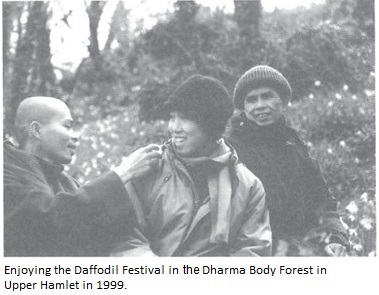
Now Plum Village also includes the New Hamlet, which is the Loving Kindness Temple, the Hillside Hamlet and the Gatehouse. Near Upper Hamlet we also have Middle Hamlet and West Hamlet. Many are surprised when they come and see that Plum Village is not what they had imagined. For example, we had forewarned a delegation of practitioners from the Buddhist Association of China before their arrival to Plum Village, saying that we had only trees and cow barns that have been converted into meditation halls and living quarters. We had told them this many times, but when they arrived they were still surprised. They had not expected that Plum Village could be so poor, simple, and rustic. Each one of us has a different understanding of Plum Village.
Novice monk, Brother Phap Can, grew up and studied in Germany and came to Plum Village to be ordained. Last year, he went back to Germany with a delegation from Plum Village, and he discovered a new Germany. During those years that he lived in Germany, he had never been in touch with the Plum Village Sangha there. This time going back, he encountered a large number of Vietnamese and German people following the practices of Plum Village. There were Dharma talks, where 3,000 and 7,000 German people attended. There were walking meditation processions with many hundreds of German people walking together. Returning to Germany, he discovered a completely new Germany. Plum Village exists in Germany, but he had never seen it during the seven or eight years he had lived there. We have to find the truth with the eye of signlessness. Plum Village elements exist everywhere; they exist in our own hearts.
Coming to Plum Village with a camcorder does not necessarily mean that you can record Plum Village. Plum Village is not a Vietnamese temple that is set up on European land. In Plum Village, we see the Indian culture, the Chinese culture, the Vietnamese culture, and the Western culture. When we look at Plum Village carefully, we see that non-Plum Village elements exist in Plum Village. Consequently, Plum Village is also an object of meditation. The deeper we look into it, the more clearly we see it. Otherwise, looking at Plum Village, we only have a superficial and vague notion about Plum Village. If we look at it deeply, we see that Plum Village is also unborn and undying.
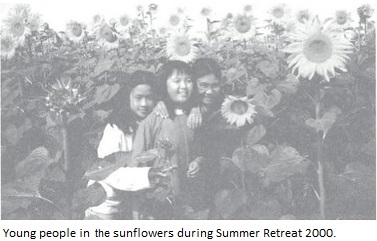
A few years ago, when we went to visit the Jeta Grove in India, one of the places where the Buddha lived, we found that the Jeta Grove Monastery was no longer there. A group of Japanese archeologists came to excavate the area, and they discovered remnants of many large monasteries adjacent to one another, buried under the earth over time. They could identify the places where the monks slept, the Buddha hall, the teaching hall, and so on. Yet, we know that the Jeta Grove has never died, because when we go to other countries like Japan, China, Korea, and Tibet we see that the Jeta Grove is still there in its new forms. Thus, the true nature of the Jeta Grove is that of no-birth and no-death. Plum Village is the same. For example, if tomorrow Plum Village is closed down, and people build large shopping malls in the Lower Hamlet and the Upper Hamlet, Plum Village will still be there in its new manifestations everywhere, especially in our hearts. When we come to Plum Village, we must look at it deeply to see its nature of no-birth and no-death; we must see the reality of Plum Village beyond all forms.
Old Path White Clouds
The first years during the Summer Opening, I stayed in the room above the bookshop in the building near the Linden tree in the Upper Hamlet. We had very few rooms then, and I had to share the room with four or five children. They slept with me and at night they sprawled out on the floor. I thought that children needed to sing; that chanting alone was not enough. I intended to write the song, "I take refuge in the Buddha, the one who shows me the way in this life ... " for the children to sing. In the afternoon we did sitting in the mediation hall called the Bamboo Hall. The walls are made of stone. Facing a big block of stone, the tune for the song came to me. "I take refuge in the Buddha, the one who shows me the way in this life," then "Namo Buddhaya." I thought to myself, I am here to do sitting meditation and not to make up songs. Let's continue it after the sitting meditation. However, after a few minutes, the music returned to me. I thought, if it's - going to be like this, I may as well compose the song now. So I continued writing that song and, after the meditation, I recorded it in order not to forget it.
I remember at that time I was also writing the book, Old Path White Clouds. We did not have central heating yet, only a wood stove in the room and the weather was very cold. I wrote with my right hand and I put my left hand out over the stove. I was very happy writing that book. From time to time I would stand up and make myself a cup of tea to drink. Every day the few hours I spent writing was like sitting with the Buddha for a cup of tea. I knew that the readers would have much happiness while reading the book because I had so much happiness while writing the book.
Writing Old Path White Clouds was not hard work, it was an immense joy. It was also a time of discovery. There were sections that were, to me, more difficult than others. One section was when the Buddha first gave teachings to the three Kasyapa brothers and received them as disciples. There are some documents that say that the Buddha had to use miracles to do it, but I didn't want to retell that he did it with miracles. I wanted to show that he did it with his compassion and understanding. The Buddha has a great capacity of understanding and compassion so why would he have to use miraculous powers? I had a strong faith that I would be able to write the chapter in that light. That was the most difficult chapter for me to write in Old Path White Clouds, but eventually I succeeded.
The second most difficult chapter was when the Buddha went back to visit his family after having already becoming enlightened. He was still the son of his parents and a brother to his siblings. I wished to write in a way that would retain his human qualities. The way he took the hand of his father upon their meeting, the way he related with his younger sister, with Yasodhara and Rahula was very natural. I could only write in that way because I felt the ancestral teachers were supporting me. In reading Old Path White Clouds, we find that Buddha is a human being and not a god because that is precisely the aim of the author, to help the readers rediscover the Buddha as a human being. I tried to take away all the mystic halos that people ascribe to the Buddha. Not being able to see the Buddha as a human being makes it difficult for us to approach the Buddha.
Blossoms of Awakening
I became a monk in Vietnam. I grew up in Vietnam. I learned and practiced Buddhism in Vietnam. Before coming to the West I taught several generations of Buddhist students in Vietnam. But I can say that I realized the path in the West. In 1962, at Princeton University, where I came and learned more about the history of religions, I began to have many deep insights, flowers and fruits of the practice. If you have read Fragrant Palm Leaves you will see that my going to Princeton was like going into a monastery. It was far from all the pressing demands of the current situation in Vietnam. I had much time to do walking meditation, assisting the maturation of insights that had not yet ripened. I wrote the book, A Rose for Your Pocket in the summer of 1962. It is a very simple book but is in fact the fruit of awakening. It is in this book that the practice of "dwelling happily in the present moment" is first described. Each of us has a mother. A mother who is as fragrant as the "fragrant banana" or delicious as sweet rice or as sweet as sugar cane. Aware of those qualities of your mother, do not live superficially with your mother but live with full awareness. We need to live in a way that does not cause the wonderful things of life to slip right through our fingers. We need to live deeply with each moment in the present. This is what is contained in that little book. A Rose for Your Pocket can be considered as the first blossom of my awakening. And since then, that insight has just continued on its path of deepening.
The shortest and most profound Dharma talk I can give is "I have arrived, I am home." Only six words. And this morning, I shared with Sister Chau Nghiem that, "I have arrived, I am home" can be considered as the Dharma Seal of Plum Village. Any Dharma talk, any teaching which goes against the spirit of "I have arrived, I am home" is not truly a teaching or method of practice of Plum Village. That Dharma seal was first expressed in that little book, A Rose for Your Pocket.
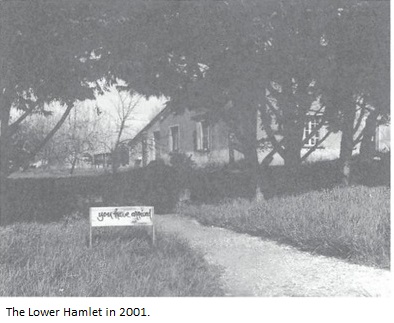
In 1974, while I was working for peace in Paris I wrote the book, The Miracle of Mindfulness. I wrote it out of love for my monastic and lay students who were working in Vietnam in the dangerous circumstances of wartime. I wrote it for young social workers in Vietnam, monks and nuns and lay people. After that book was written I sent it to Vietnam to be published and over here I thought that our friends who had supported the work of calling for peace could also enjoy the practice as it was expressed in that book. So it was translated into English. This is a book that teaches us how to dwell in the present moment and to live mindfully with awareness of what is happening within us and around us. Between the writing of A Rose for Your Pocket in 1962 and The Miracle of Mindfulness in 1974, there was twelve years during which I wrote and published many titles. In those twelve years you can recognize the progressive change in my way of looking at things. That was the process of the blooming of a lotus.
In my life of practice I have had the opportunity to bring Buddhism back to the stream of the original teachings of the Buddha. Before coming back to the original stream of teachings, I already had the insight into dwelling happily in the present moment. Once back in the stream of the original teachings, that insight was experienced fully and with more clarity.
The book The Miracle of Mindfulness was published by Beacon Press and up until now, more than two decades later, this book is still in print and continues to sell very well. The Miracle of Mindfulness is a mediation guide that you can use if you want to share the Plum Village style of practice with people. Those of you who have not read The Miracle of Mindfulness should find a copy and read it. It has been translated into at least thirty different languages.
The meditation of mindfulness is the basic practice of meditation in Plum Village. Mindfulness means dwelling in the present moment to become aware of the positive and negative elements that are there. We should learn to nourish the positive and to transform the negative. Twenty years of Plum Village has helped me to learn so much and has helped the Sangha of Plum Village to grow up so much.
Going as a River
In May 1966 when I left Vietnam I did not think I would be gone long. But I was stuck over here. I felt like a cell of a body that was precariously separated from its body. I was like a bee separated from its hive. If a bee is separated from its hive it knows very well that it cannot survive. A cell that is separated from its body will dry up and die. But I did not die because I had gone to the West not as an individual but with the support of a Sangha's visions. I went to call for peace. At that time our work in the areas of cultural development, education, and social development had strong momentum. We had established the Van Hanh University, a University for Higher Buddhist Studies, the School of Youth for Social Service, the La Boi printing press, and the weekly newspaper Hai Tri eu Am (The Sound of the Rising Tide.) We also had a campaign calling for peace within Vietnam. I went with all these things in my heart so I was not in danger of drying up. If I had gone as an individual, looking for a position, for a bit of fame then I surely would have dried up. The life and death issue is Sangha building. That is why I began building a Sangha with the people who were helping me do the work of calling for peace. The people who helped me were pastors, priests, professors, high-school students, and university students. I met with them, befriended them and invited them to join the path of service for peace.
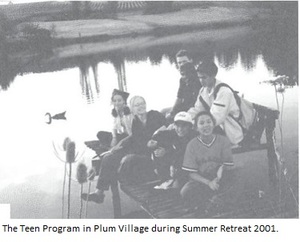
From 1968 until 1975 I established and lead a delegation in Paris of the Vietnamese Buddhists for Peace. During this time, many young people came and volunteered to help us. They would work, and at lunch time we offered them a simple meal. After dinner they stayed on to practice sitting meditation. Along with sharing the practice of sitting meditation with the young people, we also shared how to practice walking meditation, deep relaxation and singing. When we were working for the Delegation of the Unified Buddhist Church of Vietnam in Paris, we organized sitting meditation sessions for Western practitioners in Paris once a week at the Quaker Center on Vaugirard Boulevard. By offering the practice to the young people who came to help with the social work and the peace work, many seeds were sown. This may be one reason why many young people came when we first organized the Summer Opening in Plum Village.
When I was in touch with individuals and communities who were very concerned about peace and social work, I saw that they had difficulties. After working for a period of time, they became divided, they grew tired and abandoned the cause. Thus, meeting with any organization or any individual, I shared with them my methods of practice. Before we had the Sangha gathered together in one place, we already had the Sangha as individual elements in many places.
Pastor Kloppenburg of Bremen, a Lutheran pastor in Germany, was someone who loved me very much. He initiated and organized occasions for me to give talks calling for peace everywhere in Germany and he helped me translate and publish the book, A Lotus in a Sea of Fire in German. He also provided material support for me to send to Vietnam so the School of Youth for Social Service could continue its work of service. He helped me to organize the peace talks in Paris. In Holland, there was Minister Hannes de Graff of the Dutch Reformed Church and he supported me immensely. On the path of calling for peace in Vietnam I made many friends in the religious circle, in the human rights circle and with the younger generation.
When we first established the Vietnamese Buddhist Peace Delegation in Paris, we faced many difficulties, such as getting residential permits, finding enough food to eat and clothing to wear. During that time, our headquarters was small but housed so many people. There were nights when Sister Chan Khong, who had been a professor at a university in Saigon, had to ask to sleep overnight at a restaurant because we ran out of sleeping space. Instead of buying regular rice at a supermarket, we bought the cheaper broken rice, usually sold as birdfeed, from the pet store. One day the man who was selling the broken rice asked us, "Why do you come and buy so much rice? You must have a lot of birds in your house." And we said, "Yes, many, nine in all, and each one is very big!" And we showed with our hands how big those birds were. But our life was full of happiness. I found a place to teach and I received one thousand French francs as a salary every month. Other people in the delegation also had to find work. Sister Chan Khong used to teach mathematics and tutor young students to add to our income.
There was a period when I took a course on printing as a trade. I am still a good printer and can bind books quite well. I always printed and bound books in mindfulness. I have printed several dozen books and I have bound thousands of books. At that time La Boi, the printing press of Vietnamese books, had not yet moved to the United States and we did the printing in France.
In all the years of my exile from Vietnam, I have never felt cut off from my Sangha in Vietnam. Every year I compose and send manuscripts to Vietnam and our friends in Vietnam always find ways to publish our books. When they were banned, the books were hand-copied or published underground or published under different pen names.
There are still many people in our Sangha who sleep in a sleeping bag. Sister Chan Khong still sleeps in a sleeping bag. In Plum Village I used to sleep on a very thin mattress on a plank of wood on top of four bricks. That fact does not prevent me from being happy. I have never wanted to build a luxurious, beautiful monastery here. When I am able to sell my books that money has been used to bring relief to the hungry and to victims of the floods in Vietnam.
From being like a cell that had been separated from my Sangha body in Vietnam, I was able to practice cloning and not only did I not dry up, like a bee separated from its hive, from a cell I have become a body. And that body became the Sangha body as we see today. The important factor is that we need to go with our heart full of our Sangha, then we will not dry up and die. I have said the other day that if you have come to Plum Village, you have to take home with you no less than Plum Village in its entirety. Bringing Plum Village home, you will be able to survive longer. The teaching and practice of, "I have arrived, I am home" always complements the teaching of, "going as a river and not as a drop of water." If you are a drop of water then you will evaporate halfway, but if you go as a river you will surely reach the ocean. I have never gone as a drop of water. I have always gone as a river.
Responding to Suffering

When we were working in Paris, the Vietnamese Buddhist Peace Delegation was able to sponsor more than 9,000 orphans resulting from the Vietnam War. We didn't support the building of orphanages but we tried to find relatives of the orphans to unite them. We would send twenty-five French francs each month to those families to buy food and school supplies for the orphans. At that time I was very busy with different work, but every day I also spent some time to translate the files on the orphans. I was given twenty files of orphans each day. The files were made and sent to us in Paris by our social workers in Vietnam. There was a photograph of each orphan, the name of the father and the mother, and how the father and mother died. We had to translate these files into English, Dutch, French and German to find sponsors for each chiId. I used to hold up the file with the photograph of the child. Looking at the face of the child, I would smile and breathe. The energy of compassion would come up in me and my heart was full of love. Then I would be able to translate them easily, the translation was very poignant because there was a lot of love and compassion flowing out of my pen. There was a Danish lady who was so inspired to help us with the program for orphans that she took a course to lean Vietnamese. Her Vietnamese was good enough to help translate the files.
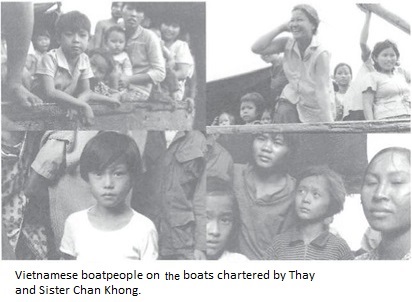
In 1975 when the Americans left Vietnam and the North took over the whole of Vietnam, our Sangha in Paris retreated to a hermitage in the countryside of Paris, Sweet Potato Hermitage, where we had gone every weekend to rest and renew ourselves. At Sweet Potato Hermitage, I wrote the books, The Moon Bamboo and The Sun My Heart and the second and the third volumes of The History of Vietnamese Buddhism. Sweet Potato Hermitage is still there. We should organize a pilgrimage there one day as a fun outing. It is near the forest of Othe. It is very beautiful and the climate is colder than Plum Village.
During this time at Sweet Potato Hermitage, from 1975 till 1982, Sister Chan Khong and a number of others in the Sangha organized relief work for the refugees, the boat people, who were escaping Vietnam at that time. We rented three boats, The Leopold, The Roland and The Saigon 200. We used these boats to transport the boat people on the ocean. Our aim was to pick them up on the ocean and to secretly take them to other countries like Australia. Once, we rescued five hundred and fifty people on our boat but our underground work was exposed. Both Sister Chan Khong and I were driven out of Singapore because we had secret headquarters there. The reason why our work was exposed was because some journalists were scouting for news. If this had not happened the refugees we rescued would have been taken to Australia to be processed as immigrants sooner. But instead, we had to turn them over to the United Nations High Council on Refugees. Those boat people had to stay in refugee camps for three, four or five years before their cases were finally reviewed and processed for immigration . So unfortunate!
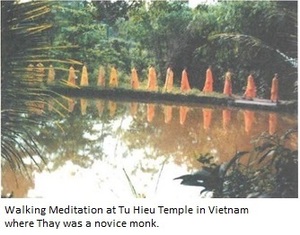
Before Sister Chan Khong left Vietnam to come and help me, she worked energetically and in high spirits with the School of Youth for Social Service. She has been present with me from the beginning of 1968 until now, supporting all the work for peace and social work. Since 1968, she has constantly worked, never once having the idea of giving up or surrendering. Of course I have had many other friends and many other disciples, but some have given up because there are many dangers, difficulties and obstacles on the path of calling for peace, human rights and building up Sanghas. Because of their difficulties, either personally or from the environment, others have abandoned the cause. But Sister Chan Khong has always accompanied me from the beginning to the end with great dedication.
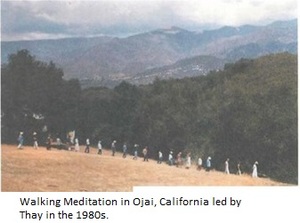
A Meeting of East and West
The difficulties that we encountered in the process of establishing Plum Village were the problems that the Buddha also had but there were also new difficulties. We have benefitted from the experience of many previous generations of practitioners and we have also grown and learned from the difficulties of our own time.
One difficulty that the Buddha had a little of and we have had a lot of is the differences between cultures. Our Sangha is made up of twenty or more different nations and cultures. Plum Village is not a Vietnamese temple set up in Europe. It has roots in Vietnam but it has also had to grow and be appropriate for the environment in which it is growing. When we bring plants from Vietnam and we plant them in the West they do not grow the way they would in Vietnam. When we grow mustard greens in France they grow thorns, which would never happen in Vietnam. We have to know how to adapt to our surroundings and we have to know how to absorb the beautiful things from the cultures around us. Sometimes people from both the East and West come to Plum Village and find forms of practice that are not suitable for them, because they carry expectations that Plum Village will be like their respective cultures. But it is a combination of both. When a person from Asia hangs clothes out to dry, they hang the trousers lower than the shirts and the two legs have to be hung close together. It would be very strange for an Asian person to see them hung up any other way. If we use a normal bowl to feed the cat an Eastern person can never accept that. The bowl that the cat eats out of should be different from what humans eat out of. When a Western nun cooks, putting all her heart into cooking, a Vietnamese nun may look at the food and go somewhere else to eat instant noodles. This makes the Western nun very unhappy. This happens every day in Plum Village. So the cultural gap is there and it brings difficulties. It is not anyone's fault, it is just differences.
If you want to offer something you have to have that thing in order to offer it. In the Vietnamese Buddhist tradition there are many jewels. But if we want to offer them we have to have them within ourselves. We have to put our roots down in our own tradition very deeply. We must put our roots down in our educational tradition, our ethical tradition, our cultural tradition, and in our spiritual tradition in order to be able to share them with others. We have to keep the most beautiful things in our culture to be able to offer them to others. The most beautiful and precious things I have received are not something I can ever take out of me. I can bring them out and share them, but how can I share them if people cannot accept them? In the process of sharing the practice we have to learn to understand the culture and the environment of the West. We have to present our own jewels in the way that is appropriate to the Western way of thinking.
There are two things necessary to transmit the teachings we have received. We have to have things firmly in ourselves and we have to understand the culture of the people we are offering the teachings to. If we don't understand anything about the language or the behavior of the Western people how can we offer these things? There are teachers from the East who come to the West who have jewels from their own cultures but they have not understood the Western culture and so there is no way they can transmit their jewels to Western people. You have to understand Western culture and then you can share the jewels of your tradition. In these last thirty-five years I have learned so much in this process.
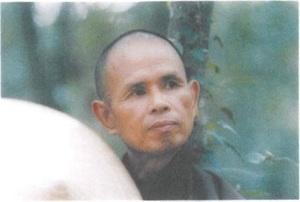
I have not only learned from Westerners but I have also learned from the East. In the light of Western culture I have seen the beauties of the East in a way that I had not recognized before. Before I was only able to see 70% of the beauty of Vietnamese culture. But now under the light of Western culture I can see 90% or more of the beauty of Vietnamese culture. I have learned from the place where I am teaching and also from the place where the jewels came from. When Western friends come to Plum Village they also have to have their roots in their own culture and in their own spirituality. Then they have something to share with us. It is not that they are hungry ghosts, wandering around and that they have nothing to offer to us. If they have put down their roots in the Western culture and they come here they will have something to offer us. And because we are open we can receive from them and both sides will profit. The most basic condition to have a successful exchange between peoples of different cultures is for each person to have his or her roots firmly established. This is a process that takes place year to year and Plum Village is still in the process of learning these things.
Renewing Buddhism in Asia
Plum Village has contributed a great deal not only to Buddhism in Europe and the United States but also to Buddhism in Vietnam and other areas of Asia. If I did not have monastic disciples in Plum Village I would not have been able to write the book, Stepping into Freedom. It is a handbook that shares practical guidance and requirements for a novice. The book that is currently being used by novices in Buddhist countries was written over 400 years ago. I sensed that it was outdated and no longer appropriate. I sat down with my disciples to compose Stepping into Freedom, which has thirty-nine chapters on mindful manners instead of the original twenty-four. This new handbook includes mindful manners on such areas of practice as how to use a computer in mindfulness and how to facilitate discussions about the Dharma. The ten mindfulness trainings (novice precepts) are also presented in a very complete, practical and beautiful way.
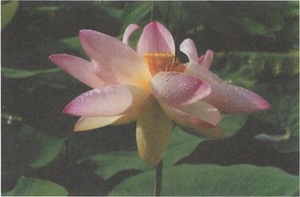
If we did not have the monastic Sangha here we would not have been able to offer to Vietnam the daily chanting book, written in modern Vietnamese, which many temples are now using. (Most traditional chanting books used in Vietnam are written in old or Sino-Vietnamese, which most people do not understand.) We now have a book for reciting the Bhiksu and Bhiksuni precepts in Vietnamese, English and French as well as the Grand Ordination ceremony in Vietnamese, English and French. While teaching the monks and nuns in Plum Village we have been able to write and publish many reference books that temples, meditation centers, and Buddhist universities in Vietnam and other countries in Asia can use and benefit from. For example, The Heart of the Buddha's Teachings, a book on basic Buddhism as taught to monks and nuns, is being used as course material in many Buddhist institutes in Vietnam by young Dharma teachers.
We have also created a four-year training program for monks and nuns. Upon completion, monastics are capable of organizing retreats and leading Days of Mindfulness. After being a monk or nun for five years you can be a candidate for receiving the transmission of the Dharma lamp to become a Dharma teacher. In Plum Village we have three kinds of Dharma teachers: monastic Dharma teachers, lay Dharma teachers and honorary monastic Dharma teachers. During the Winter retreat 2001-2002 we had the Lamp Transmission Ceremony in which thirty monastic and lay practitioners. About seventy monastics and thirty lay people have received the Dharma Lamp in Plum Village and have led retreats all over the world. There are also numerous honorary monastic Dharma teachers who received the lamp at Plum Village and are teaching in Vietnam.
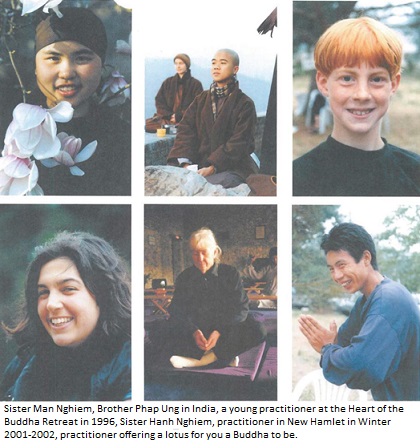
In Plum Village during the winter retreats, the monks and nuns have the benefit of long courses which allow deeper learning. For example, we have had retreats on the living traditions of Buddhist meditation, on Plum Village practice, on the Southern and Northern transmissions including the major sutras like the Prajnaparamita Sutra, the Lotus Sutra, and the Flower Adornment Sutra and on Nagarjuna's Madhyamika Shastra. The material from some of those retreats has been transcribed and made into books and monastics in Vietnam have benefited from them. Thus the practice and study of monks and nuns in Plum Village has contributed a great deal to the study and practice of Buddhism in Vietnam, Europe and America.
The Relationship of Teacher and Disciple
Early on I trained several generations of monks and nuns in Vietnam. I looked after the young monks and nuns with all my heart and thought taking care of them was enough and that I didn't need to have disciples of my own. When I came to the West I still had that idea. Then one day I saw clearly that if I don't have a direct teacher-disciple relationship, the practice of the disciple would not deepen. When I taught the students in meditation centers in North America and in Europe there was a link, a relationship of teacher and disciple. But after I left the relationship weakened and therefore the students never really matured in the practices I offered. The students did not practice the teachings offered continually and ceaselessly because of the lack of the teacher-disciple connection. After that I decided that I would have monastic and lay disciples. I saw that the relationship between teacher and disciple is very important, not only for the disciple but for the teacher as well. I have learned a lot having disciples living and practicing with me.
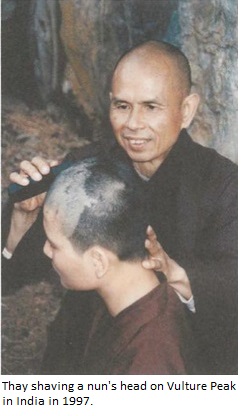
The relationship with my students, which is direct and continuous, has helped me to see the ways of teaching which can most likely ensure success. It brought together the teachings and practice, of the mindfulness trainings and fine manners, so that the teachings and practice are not separate from each other. Through the course of teaching and our practice as a Sangha, we have been able to produce wonderful Dharma doors which lay and monastic people can use. For instance the idea of the Sangha body, the Sangha eyes, Shining Light, touching the earth and the second body system are the fruits and flowers of our practice here in Plum Village. They are not only used by monks and nuns but also by lay people. The presence of monks and nuns in Plum Village has brought me much happiness. The basic reason is their commitment for their whole life to the practice and their determination to go on the path of our ideal together. In Plum Village, monks and nuns vow to live together as in a family for the rest of our lives.
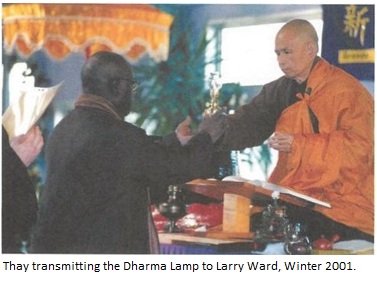
In the past I also taught several generations of monastic disciples but I was never as happy as I am now as teacher and disciple live together and practice together. Every day I find ways to transmit to my disciples all that I have realized for myself, like the first banana leaf transmitting and sending nourishment to the second and third leaves. The happiness which monks and nuns give me is very great. Monks and nuns in Plum Village all have beauty, sweetness, bright smiles and twinkling eyes. I don 't know if they were so beautiful before they became monks and nuns or whether they became beautiful afterwards. Or is it just because I am like any other father and mother that I see my own children as more beautiful than other people's children? But I do see them as beautiful, whether they are from North America or Europe or from Asia.
I think some of you must agree with me. Just a few hours after the ceremony for transmitting the novice precepts their faces are so much more radiant, their two eyes more bright and their smiles fresher. That has to do with their determination, their commitment, and with the precepts' body. Sitting with the monks and nuns to drink tea or to have Dharma discussion, to talk about happiness in the present and the future is one of the things I like doing best of all I spend a lot of time with the monks and nuns and that time brings me a great deal of happiness.
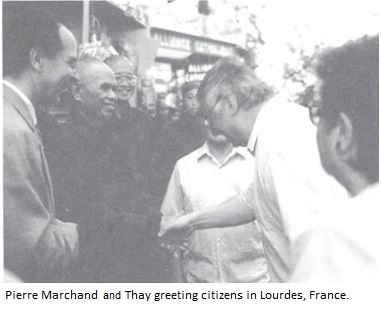
When monastic and lay disciples do something wrong, clumsy or unskillful that brings about difficulties and suffering the Sangha should help them. I have learned over thirty years not to use my authority as a teacher to resolve conflicts. We have to use awakened understanding and love. This has to be applied both in the East and in the West. If we do not do this we will not be successful as a teacher. Often our disciples cannot see the mind and heart of their teacher. We have to be patient. They think that their teacher's heart is as small as a peanut. We think that Thay does not allow us to receive the precepts because he is punishing us, because he does not love us. We do not know that our teacher's deepest desire is to see his disciples grow and to become big sisters and brothers for all our little sisters and brothers, to take our teacher's place. The more they can do that the happier Thay is.
Therefore, the teacher is someone who has the capacity to allow his students to make mistakes. We have to learn from our mistakes. When we are a teacher we have to have the capacity to see all of our disciples as our continuation. We have to help everyone to grow up. We don't just want to support one or two of our disciples. We want everyone to grow up like all mothers and fathers want all their children to grow up. If we are an older brother or sister in the Sangha we have to look after every younger brother and sister equally. If we do that we already have begun to be a teacher. If we know how to love all our disciples with equanimity, then when we officially become a teacher there is no reason why we should not be successful.
I really want there to be lay people practicing with the monks and nuns in all of our monasteries, to be a bridge between the monastic community and the lay people in society. We can really call these lay people upasika (lay disciples who have received the five mindfulness trainings) because they are close to the monks and nuns. With deep understanding, they will then have the capacity to hand on the insights and the happiness of the monastic Sangha to the community of lay people at large. There are many lay people in the Order of Interbeing and that is one of the reasons why we have made progress in developing the Order of Interbeing and sharing the practice in so many places. They are not like other lay people because they have received the fourteen mindfulness trainings. The fourteen mindfulness trainings are like a bridge which connects the monastic community to the lay community.
The Order of Interbeing began in 1962 with six people. Sister Chan Khong and Sister Chi Mai were among the first six core members of the Order. Today there are more than 700 members of the Order of Interbeing and they are present all over the world. Now we want to establish lay communities led by lay people like Intersein in Germany led by three lay Dharma teachers and Clear View in Santa Barbara, California led by two lay American Dharma teachers. We hope in the following years of the twenty-first century that there will be many similar lay centers led by lay members of the Order of Interbeing. We also hope there will be many Mindfulness Practice Centers set up to offer a secular practice of mindfulness without religious overtones. In these centers, people from any belief can come in order to comfortably practice, without fee ling they have to abandon their root religion and convert to a new religion.
Buddhism Beyond Religion
When I was last in China I met with the vice minister of religious affairs. We offered his department a calligraphy saying "The Spiritual Dimension." My idea was that although China is developing and strengthening many aspects of their society: the economy, education, the arts, and politics, the people still suffer if they lack the dimension of spirituality in their lives and activities. Giving support to Buddhism so that Buddhism can contribute to that spiritual dimension will help people in China suffer less.
Last winter the School of Medicine of a university in Geneva asked me to come and speak about the human brain. They have organized a week-long symposium on the brain and are gathering neuroscientists and brain specialists to offer illumination on this topic. I am not a brain specialist, but they invited me because they want to have the spiritual dimension represented. Also I was invited to contribute to the international conference of politicians and business leaders of major enterprises held at Davos, Switzerland. Neither am I a businessman, so why do they invite me? Because they see that the business people and those in politics do have suffering, worries and fears, and they feel the need for the spiritual dimension. The medical school in Harvard has also invited me to give a Day of Mindfulness for doctors and medical researchers. The spiritual dimension is called on to bring relief to people's suffering, anxieties, and fears in all fields.
Monks, nuns and lay practitioners have to bring Buddhism out of its religious context, presenting Buddhism as a source of insight and a tradition of practice, to be able to share it with, and serve, the world. We have to bring Buddhism into prisons, schools, hospitals, and police headquaI1erS so the people in these areas can live a life with more ease and less suffering. Therefore we need to learn how to offer methods of practice that can be used in all sectors of society, without the limitations of being a religion.
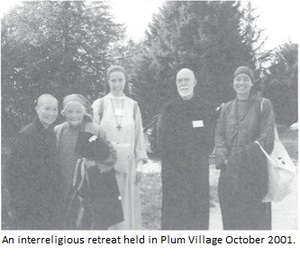
Looking at the scope of the Plum Village Sangha's activities we can see that the practice of mindfulness in daily life has been able to reach many sectors of society. We host retreats not only in Plum Village but also in other countries of Europe, America, and Asia. We have had many retreats for families, where parents, children and teenagers practice together. We have hosted retreats just for young people in the United States, Australia and Europe. We have had retreats for psychotherapists in America and Europe. We have had retreats for war veterans, environmentalists, doctors, nurses, teachers, peace activists and business people. We have brought the practice into prisons. This year the Mind/Body Institute of the School of Medicine at Harvard University wants me to come and receive an award. They say our retreats have helped heal many people and greatly relieved their suffering. We are not doctors nor are we psychotherapists but our retreats have brought rejuvenation, joy and hope to thousands of people. They want to affirm that fact with an award. This is an indication that we have been able to surpass the limits of religion and enter the main stream of society.
The Seed has traveled far
In the process of Plum Village growing up we have been able to modernize the methods of learning and practicing Buddhism. Our teachings have been received easily, enthusiastically and happily. Whenever we have a retreat, people from different religions practice together without any discrimination. Our methods of practice seem to be applicable for many schools of Buddhism as well. Whether practitioners come from Japanese Zen meditation, Korean meditation, Vipassana meditation, or Tibetan Buddhism they all come to practice together and feel at ease in our retreats.
Business people, who have participated in a retreat held in Plum Village for business people, reported that a few months after the retreat they still continue to have more insight into what they have learned. The seeds that were planted in the retreat continue to sprout bit by bit, offering deeper understanding. They now know more clearly what path they should take and what path they should not take. We have been able to present the teachings in such a way that young people and Westerners can understand them, accept them and apply them. That is quite an achievement of Plum Village, but it is not the work of one person alone or just the work of a few years. It is the work of thirty-five years that includes twenty years of Plum Village and the work of the entire Sangha.
We have been able to present the five mindfulness trainings in non-Buddhist terminology. The five mindfulness trainings are very true and very deep expressions not only of Buddhist teachings but also of the practice of Buddhism. The five mindfulness trainings are presented as a very concrete way of practicing mindfulness and not as restrictive commandments. We have also presented the fourteen mindfulness trainings as the essence and the practice of Buddhism. Many people who do not call themselves Buddhist like to recite the fourteen mindfulness trainings. We have established more than 800 local Sanghas all over the world. In large cities like London there are over ten Sanghas, within city limits. Small towns also have their Sanghas. In Israel there are Sanghas of Plum Village. In Australia, in Germany there are many Sanghas. In Vietnam there are numerous temples and Sanghas following the mindfulness practice of Plum Village. Other centers in the West also practice Plum Village practices. If you do not see these manifestations, about 800, all over the world you have not seen Plum Village.
One day while sitting in London during a retreat, I was very moved to receive letters from practitioners in Edinburgh, Scotland. I have never set foot in Scotland but the practitioners wrote thoughtful letters about their practice and about their Sangha there and shared their happiness. I was interested in Edinburgh because I had a friend who was a monk and he went there to study. He was sent to Colombo to study Buddhism but after several years he was sent to Edinburgh. He studied anthropology for several years there and then he went back to Vietnam. But he did not leave any trace. I have never been to Edinburgh but the seed of Plum Village had gone to Edinburgh and it has grown up in the soil there. That is something that surprised me and made me very happy. That is just an example of one of the many places I have never been to but the seeds of Plum Village practice have flown there. Here in France there is a kind of plant called pissenlit, the dandelion. When the dandelion plant ripens it turns white. The seeds are at the base of the white petals and the wind carries these seeds very far, maybe tens of kilometers. In the same way the seeds sown by Sanghas of Plum Village have spread very far. They have traveled into prisons, into Catholic cloisters, into schools, families, hospitals and communities in many places around the world and they will continue to go far in the future.
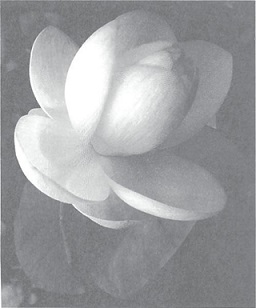
Harvesting Every Moment
Yesterday Fei-Fei, a lay practitioner living in Plum Village, asked me, "Thay you work so hard, have you yet harvested the fruit that you want?" I responded, "My dear, what else do you want Thay to harvest? Every moment of my daily life is a moment of happiness, is a harvest. As I sit with you now and teacher and disciple drink tea together, it is not to achieve anything. When we drink tea together we are already happy. To give a Dharma talk is already happiness. To do walking mediation with my disciples is happiness. To organize a retreat is happiness. To help practitioners be able to smile is happiness. What more do you want me to harvest?" Our work should be happiness. Our practice is "dwelling happily in this moment." Every Dharma talk I give has to reflect the Dharma seal of Plum Village, "I have arrived. I am home."
